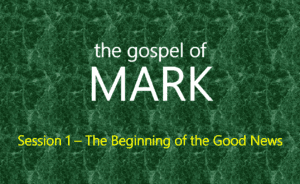

Mark 1:1-13
Jesus’s Baptism by John
In the first session we began with a comparison of Mark with the other three Gospels. Mark is by far the shortest – less than two-thirds as long as Matthew for example. Nearly everything written in Mark can also be found in Matthew or Luke. By contrast, both the style and content of John are quite different from the other three gospels.
Modern scholars believe that Mark was written around 70 A.D., the first of the gospels in New Testament canon. (This is a working hypothesis however, not a demonstratable fact.). Matthew is generally assumed to have been written around 80 and Luke somewhere between 90 and 110 A.D. The writing of John is generally placed about 100 – 110.
No author’s names were attached to the gospels when they were first written. The names Mathew, Mark, Luke and John were added around the middle of the second century.
A number of traditions grew up in the early church about the identity of the Evangelist who wrote the second gospel we call Mark. The author of Acts refers to a John Mark as a companion traveling with Paul and Barnabas early in Paul’s ministry to the Gentiles. There is a Mark associated with Peter, especially while Peter was in Rome after 60 A.D. Paul also refers to a companion named Mark in Philemon, Colossians, and Ephesians. There is no direct evidence that these are all the same Mark, or that any of them were authors of a gospel.
At one point it was suggested that Mark was a stubby fingered former priest who had cut off his own fingers to get out of the priesthood. Other early writers thought Mark might have been a young witness to both the Last Supper and Jesus’ arrest in the Garden of Gethsemane. Although there are multiple clues and traditions about the identity of the Evangelist Mark, there is no clear evidence to indicate which, if any, of these traditions is accurate.
St. Augustine (400 c.e.) thought the Gospel of Matthew was the first to be written and that Mark wrote an abbreviated summary of Matthew’s Gospel. Because many early Christian writers followed Augustine’s lead, the Gospel of Mark was frequently ignored relative to the other three gospels over most of the next fifteen hundred years. Only recently have New Testament scholars focused on Mark as an independent work. Most of today’s scholars consider Mark to be a primary source used by both Matthew and Luke in the writing of their gospels.
The Gospel of Mark is a biography of Jesus. But it is also a theological writing as well as a history – specifically a history of the introduction of God’s kingdom into the world. By its nature it is literature – a narrative or story. In future sessions we will consider not just the substance of the story, but how the narrative was put together. Because of many similarities, we will look at the Elijah-Elisha narrative (from I and II Kings) as a possible model for the Gospel of Mark.
The Evangelist Mark used a variety of techniques in his writing to tell his story. For example, Mark used a literary technique called intercalation (or “sandwiching”) to emphasize an important, but difficult idea by sandwiching it between a pair of related, yet more easily understood concepts. We will discuss several of these techniques during the course of this study.
The first fifteen verses of the first chapter of the Gospel of Mark make up the prologue. Mark begins by proclaiming the good news of Jesus Christ.
An epigraph in verses 2 – 3 quotes Isaiah 40:3, Malachi 3:1, and Exodus 23:20, and describes a voice crying out in the wilderness (Elijah), clearing the Lord’s way. In this section, Mark equates the coming of Jesus Christ to a panorama of Israel’s history.
Verses four through eight introduce John the Baptist. Here it appears that John is the messenger, the forerunner described in the epigraph. Jesus appears, and is baptized by John. The Spirit then descended like a dove. The heavens are torn open – an apocalyptic moment – and a voice (God) says, “You are my son”. It is not clear that anyone but Jesus hears the voice.
The Spirit then led Jesus into the wilderness, where he stayed forty days. He was tempted by the devil. He was waited on by the angels. In the prologue Jesus is passive. Things are done to him. He was baptized by John. The Spirit descended upon him. He was thrown into the wilderness by the Spirit, tempted by the devil and waited on by angels.
We have had a coronation followed by trial – training. Jesus is being prepared for his ministry.
Primary Text: Mark (Abingdon New Testament Commentaries), by C. Clifton Black
Coming in Session 2: Mark 1: 14-45; Mark 2; Mark 3: 1–6

 3700 West Northgate Dr.
3700 West Northgate Dr.